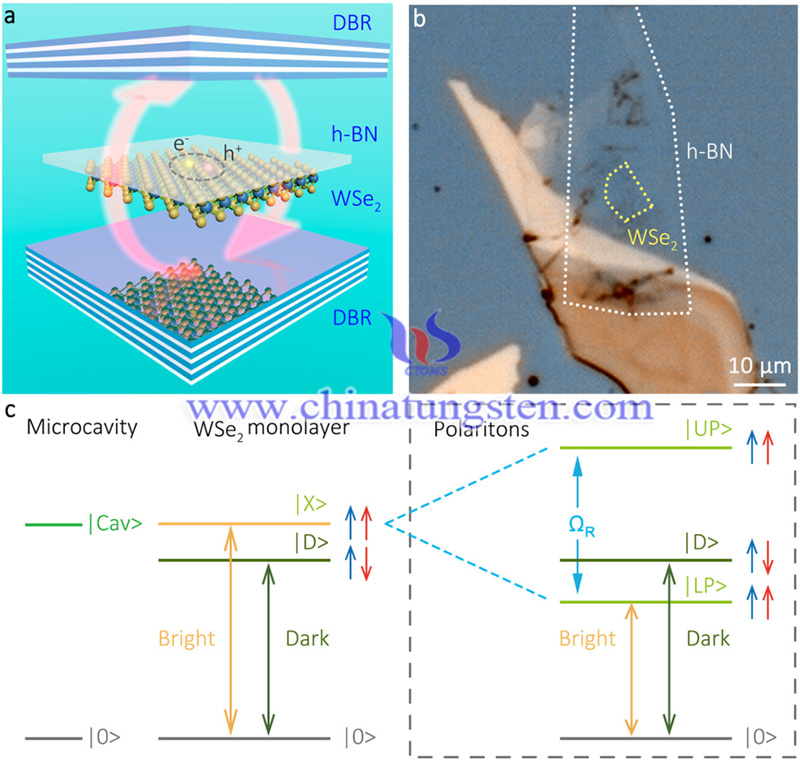Researchers Successfully Make Semiconductor Tungsten Diselenide Glow
- Details
- Category: Tungsten's News
- Published on Monday, 11 July 2022 18:19
An international team of scientists led by University of Oldenburg physicist Dr. Hangyong Shan and Prof. Dr. Christian Schneider has succeeded in creating a material - normally these materials are of low energy level - that after changing the energy level in an ultra-thin sample of the semiconductor tungsten diselenide (WSe2) to enable it to emit light.
The researchers claim that their discovery represents a first step toward using light fields to manipulate the physical properties of matter. The idea has been discussed for years, but has yet to be concretely realized.
This optical effect hosts the potential to improve the optical capabilities of semiconductors and therefore will help create cutting-edge LEDs, solar cells, optical components and other applications. This could improve the optical quality of organic semiconductors for plastics with semiconductor properties on multifunctional screens, solar cells or as sensors for textiles.
![]()
(Image Credit: University of Oldenburg)
An uncommon class of semiconductors consisting of transition metals plus one of three elements (sulfur, selenium or tellurium) includes tungsten diselenide. The scientists used a sample of a single crystal layer consisting of sandwich-like tungsten and selenium atoms in their study.
These materials, which are atomically thick, are also known in physics as two-dimensional (2D) materials. They are also called "quantum materials" because they carry charge carriers that behave quite differently from those in thicker solids, so they often have peculiar characteristics. The researchers placed a sample of WSe2 between two specially made mirrors, and excited it with a laser. They were able to use this technique to couple energized electrons and light particles (photons).
"In our study, we demonstrated that through this coupling, the structure of the electronic transition can be rearranged so that a dark material effectively behaves like a bright material, and in our experiments, this effect was so strong that the lower state of WSe2 became optically active," Schneider described. The researchers were also able to demonstrate that the experimental results reflect a theoretical model with a large degree of accuracy.
Whether a solid can emit light, for example as a light-emitting diode (LED), depends on the energy level of the electrons in its lattice. In their experiments, the researchers succeeded in manipulating the energy level structure in an ultrathin sample of the semiconductor WSe2. The team reports that the material, which normally has a low luminosity, began to emit light.
Tungsten diselenide belongs to an unusual class of semiconductors that consist of a transition metal and one of three elements: sulfur, selenium or tellurium. In this study, the researchers used a sample of a single crystal layer composed of tungsten and selenium atoms with a sandwich-like structure. In physics, such materials, which are only a few atoms thick, are also known as two-dimensional (2D) materials. They often have unusual properties because the charge carriers they contain behave in a completely different way than those in thicker solids, sometimes called "quantum materials”.

(Image Credit: University of Oldenburg)
This research is conducted by Bo Han, Christoph Rupprecht, Heiko Knopf, Falk Eilenberger, Martin Esmann, Kentaro Yumigeta, Kenji Watanabe, Takashi Taniguchi, Sebastian Klembt, Sven Höfling, Sefaattin Tongay, Carlos Antón-Solanas, Ivan A. Shelykh, and Christian Schneider. The paper titled: “Brightening of a dark monolayer semiconductor via strong light-matter coupling in a cavity” was published in Nature Communications, 2022; 13 (1).
- Tungsten Manufacturer & Supplier, Chinatungsten Online: www.chinatungsten.com
- Tungsten News & Prices of China Tungsten Industry Association: www.ctia.com.cn
- Molybdenum News & Price: news.molybdenum.com.cn
- Tel.: 86 592 5129696; Fax: 86 592 5129797; Email: sales@chinatungsten.com



 sales@chinatungsten.com
sales@chinatungsten.com